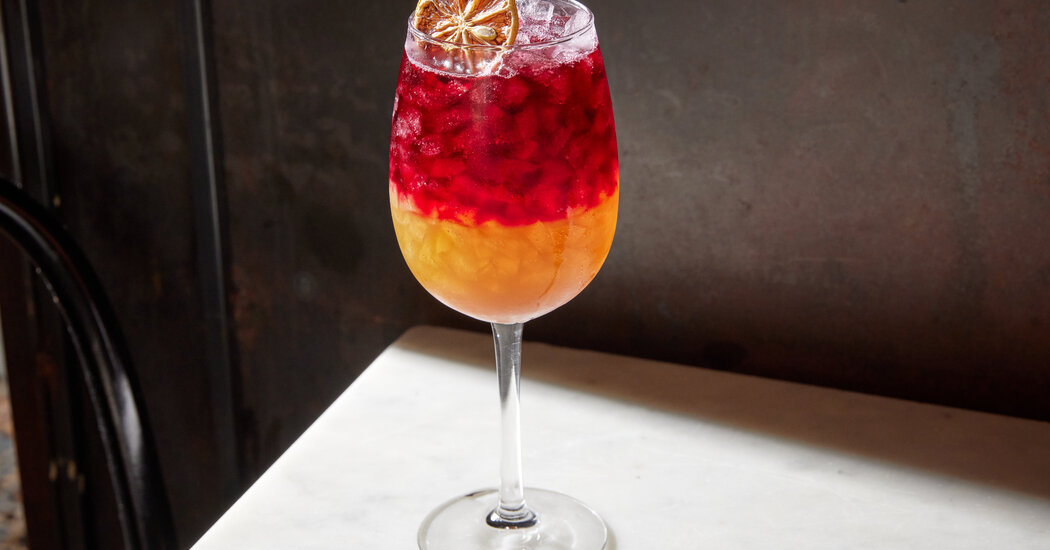
Bartenders call it “the fajita effect.” As an eye-catching cocktail sails on a tray through a room, it inspires several more orders of the same drink. Fajita favorites of recent years have included the espresso martini, all manner of blue cocktails and any drink on fire.
The latest, though, has something else in common with fajitas besides contagious appeal: layers of colorful ingredients. In a layered cocktail, the various liquid components settle out in separate strata, giving the drink a striped or ombré look.
“With the rise of people taking photos of drinks and posting it on social media, there is the aesthetic appeal,” said Conrad Hayes, the beverage director at the Brooklyn bar Ottava. Its current menu includes the Cruella de Vil, a rum drink served over crushed ice, with a crowning scarlet layer of Lambrusco.
There are two ways to layer a cocktail: floats and sinkers. A float is a stripe of liquid — whether wine, spirit, bitters or juice — that is carefully applied to the surface of a completed drink. A sinker is also poured in last but, owing to the ingredient’s weight, falls to the bottom of the glass.
In both cases, the result is striking — a major reason the drinks are popular in this visual age, when a cocktail’s looks are almost as important as its taste.
Floats and sinkers date back to before Prohibition, when a popular drink called the Pousse Café sported several layers. The New York Sour, a drink from the mid-20th-century whose popularity has rebounded in the last 20 years, is essentially a whiskey sour with a float of dry red wine. The most famous drink with a sinker is probably the Tequila Sunrise, in which red grenadine sinks beneath a mix of tequila and orange juice, giving the drink the picturesque effect hinted at in the name.
Many of the new layered drinks are deceptively simple to make. Brother Wolf, an aperitivo bar in Knoxville, Tenn., offers a layered twist on the classic Italian spritz the Bicicletta, letting the red-hued Italian bitter Select dwell at the bottom of the highball glass. The Oaxacan Sunrise at Dante in New York City, with its grenadine sinker, is basically a Tequila Sunrise made with mezcal. The drink Oh Brother, Where Art Thou, at the chef Sara Bradley’s restaurant, Freight House, in Paducah, Ky., is a New York Sour made with honey syrup.
Other cocktails, however, verge on the baroque. At Chez Zou in Manhattan, the Haifa Vice lets you apply your float yourself. The drink comes in a special glass vessel with two chambers, one filled with a milk punch made of rum, mango, coconut and fruit juices, the other with a mixture of Aperol and pomegranate. The patron pours the orange punch in the glass first, then applies the red float.
There’s another D.I.Y. opportunity at LilliStar, the rooftop bar at the Moxy Williamsburg hotel in Brooklyn. The drink Ley Lines is a mango-flavored Negroni riff garnished with a hollowed-out passion fruit filled with the fruit’s seeds and a passion-fruit liqueur. The customer adds the fruit’s contents to the drink. The bourbon-based Bad Ombré at Bad Roman is a rare specimen armed with both a floater (Barolo) and a sinker (Barolo Chinato).
There are nonalcoholic options as well. At elNico in the Penny Williamsburg hotel, Leo Robitschek has created a mocktail called Remolacha made of yogurt, green tea, grapefruit and lime juices, cardamom and beet cordial with a beet juice float. Served in a highball, it is equal parts creamy white below and deep ruby up top.
Bartenders say floats and sinkers provide more than eye candy. The dryness of a red wine float nicely counters the sweetness of some cocktails. Ian Julian, the bar director at Red Fish Grill in New Orleans — where there are now three float drinks on the menu, two of them with rum toppers — likes the added punch they provide. “I think people look for that extra hit of something,” he said.
The layered look of many cocktails slowly dissolves as the ingredients interact. Joey Smith, the bar director at Chez Zou, sees this as a good thing.
“Drinks change over time,” he said. “In general, time is a disservice to a cocktail. Either it’s warming up or diluting. I think floats are an interesting way for a cocktail to change as you drink it.”
Christine Wiseman, who creates the cocktails at LilliStar, suggested yet another way to regard a float or sinker: “It’s an expensive garnish, if you will.”
Follow New York Times Cooking on Instagram, Facebook, YouTube, TikTok and Pinterest. Get regular updates from New York Times Cooking, with recipe suggestions, cooking tips and shopping advice.






